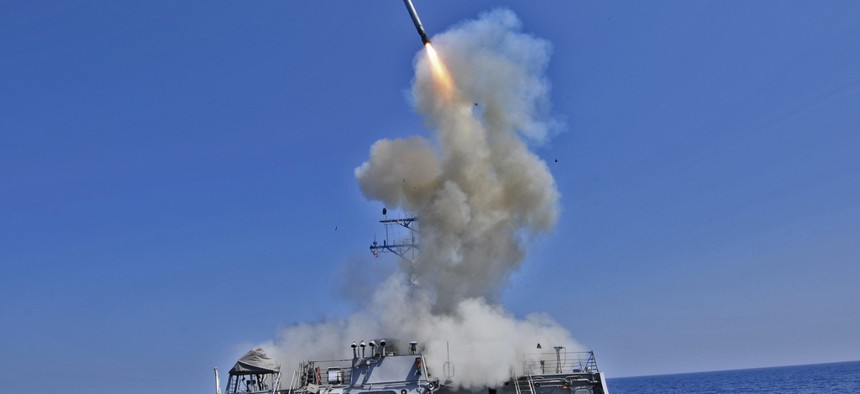Pentagon’s Syria Response Reveals Limits of Prized Cyber, Drone Arsenal
Here’s why the 'clarity' of a 20th century cruise missile strike likely will trump the 'sophistication' of the Pentagon’s 21st century drones and cyber-weapons. By Stephanie Gaskell
The United States has an arsenal of advanced warfare capabilities at its disposal that can mitigate the risks and provide a decisive edge against any attack on Syria. Stealth drones high in the sky can fly over key areas collecting intelligence and pinpointing targets. Cyber warriors far from the battlefield can plan and execute an attack to dismantle the Syrian command and control. But in the end it will come down to traditional weapons like Tomahawk missiles and B-2 bombers that will still send the strongest message.
“Using newer technology in this situation leaves opportunity for misinterpretation. If we executed a cyber-strike would the Syrians and the international community understand what we meant?” Ben FitzGerald, an adjunct fellow with the Center for a New American Security and expert on the impact of technology on conflict, told Defense One. “It could be seen as a less serious deterrent than a kinetic attack.”
“The messaging associated with more traditional weapons, like Tomahawks, is less ambiguous,” he said. “They’ve been used before and precedents have been set. Clarity and certainty is more important than sophistication.”
The Obama administration’s message, publicly, at least, is that the U.S. is not seeking to target Syrian President Bashar al-Assad militarily or become entangled in a civil war. “The goal here is to make clear that [the use of chemical weapons] is unacceptable; that it is a red line that has been crossed, and it is a red line that was established by 198 nations -- 98 percent of the world's population,” White House spokesman Jay Carney said during a White House briefing on Tuesday. “And to allow it to happen without a response would be to give a green light to the Assad regime and other potential users of chemical weapons that there will be no consequences to the use of chemical weapons.”
The best way to deliver that message? Move U.S. Navy ships to the Mediterranean Sea, loaded with cruise missiles. Amass air power at nearby bases in Cyprus, Jordan and Kuwait. Gather strong allies like Britain and France.
[Click for Defense One's complete coverage of Syria.]
The U.S. military has certainly been using high-tech capabilities like drones and cyber warfare to tip the advantage while President Obama and his allies decide exactly what kind of action to take against Syria for the chemical attack that killed hundreds of civilians last week outside Damascus. While no strikes have been authorized, or reported, unmanned aerial vehicles have been flying over the skies of Syria for some time now, and military cyber commanders have been looking for an electronic edge to help end the two-year civil war.
“Cyber could be very powerful in an operation in Syria for degrading air defenses or command and control but those actions alone would not slow the violence or stop future chemical attacks. It would be an enabler for other military options,” FitzGerald said.
In Libya, two years ago, the Pentagon considered using a cyber attack to disable Moammar Gadhafi’s air power. But that plan was abandoned, The New York Times reported, because of fears that it might embolden countries like China and Russia to do the same. “It was apparently ruled out, both because there was not enough time and also because cyber capabilities are like a Ferrari which should be saved for the big race,” said Jason Healey, director of the Cyber Statecraft Initiative at the Atlantic Council.
“If the Obama administration does conduct military strikes against Syria, it should use military cyber weapons at the earliest possible moment to show the upside of military cyber power,” Healey said. “So far, U.S. policies have emphasized all the wrong international norms, like unrestricted cyber espionage or covert cyber operations outside of wartime, and this is what much of the world thinks U.S. cyber power is about. Such operations, especially now that they have been exposed, were never in the long-term U.S. national interest.”
As the war drums beat in Syria, the Pentagon is still struggling with how drone and cyber attacks should be used on the battlefield. Cyber technology has been used with some kinetic effect in Afghanistan, but as then-Air Force Chief Gen. Norton Schwartz said in 2009 remarks to the Brookings Institution, “Traditionally we take down integrated air defense via kinetic means.”
The Air Force requested $4 billion for cyber warfare in fiscal 2013. “Now we’re using information, and the more you have the less of the older kind of weapons you need,” John Arquilla, a professor of defense analysis at the Naval Postgraduate School, told World Affairs Journal.
NEXT STORY: The War After the War in Syria






